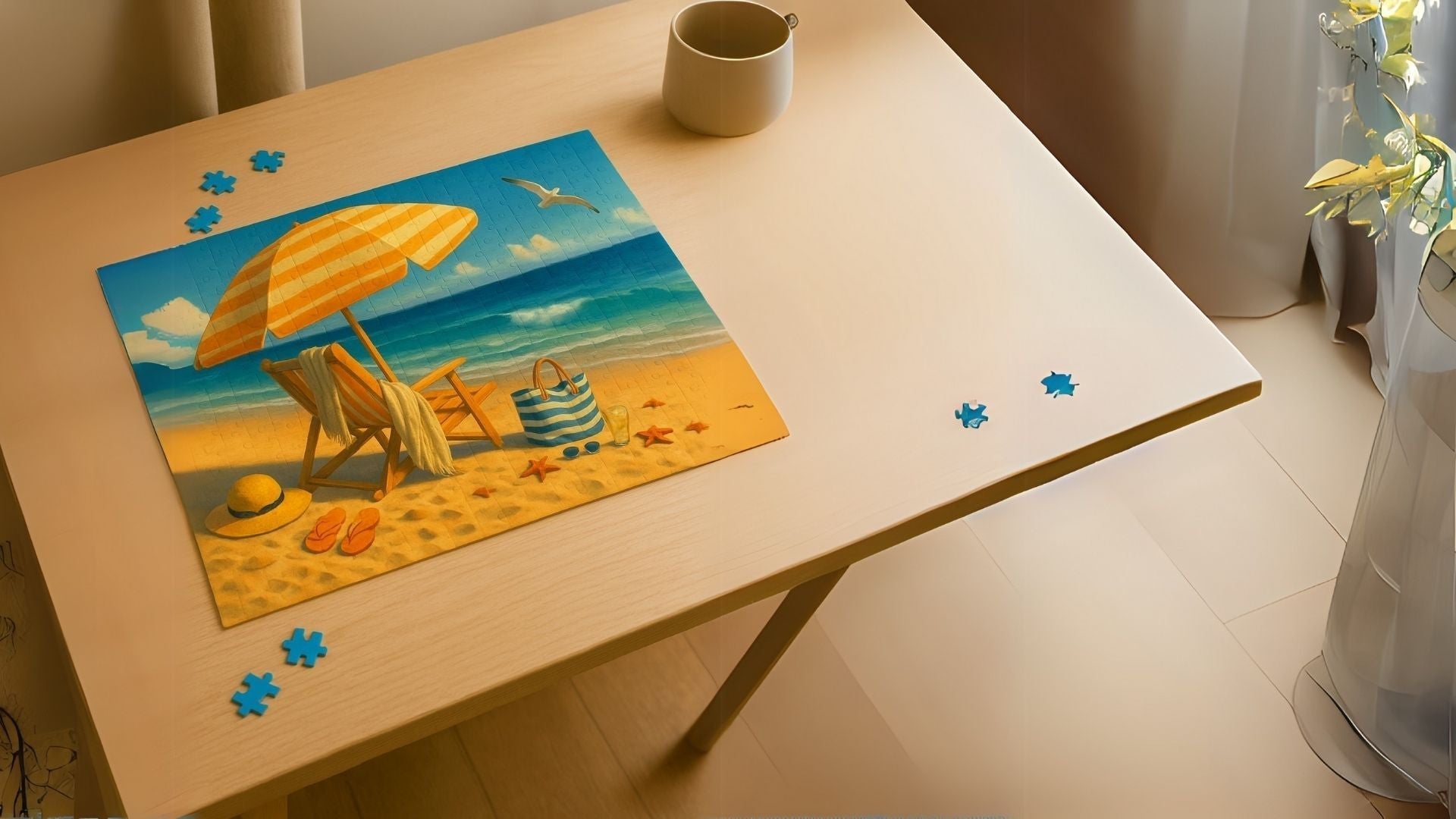Not Just a Pastime—A Path Back to Peace
There’s something uniquely timeless about the act of puzzling. It asks nothing of us but presence. No notifications. No noise. Just shapes, color, and quiet effort.
During summer—when the world speeds up with travel plans, social events, and relentless sunlight—puzzles offer an unexpected form of refuge. They invite us to slow down and settle into a different kind of rhythm. One that is calm, contemplative, and fully immersive.
And it’s not just nostalgic. It’s neuroscience.
What Science Says About Puzzles and the Mind
Research continues to affirm what seasoned puzzlers already know: the humble jigsaw is good for the brain.
According to a 2020 study published in Frontiers in Aging Neuroscience, jigsaw puzzles activate multiple cognitive functions at once: visual-spatial reasoning, short-term memory, attention span, and pattern recognition. Even better? These effects are heightened when done in silence or during relaxed states—like those naturally created by mindful summer evenings.
Neurologically, puzzling has been shown to activate the same parts of the brain as meditation. The prefrontal cortex is engaged (attention and focus), while cortisol levels decrease, bringing a sense of emotional regulation and calm. In fact, one study published in Brain and Cognition found that puzzle-solving helps create a “flow state”—a meditative, time-dissolving mental experience that increases happiness and reduces stress.
So no, it’s not “just a puzzle.” It’s braincare disguised as leisure.
Why Summer Is the Perfect Time for Mindful Activities
Summer tends to be portrayed as fast-paced—beach trips, barbecues, parties—but many people find themselves craving slowness amid the sunshine. Quiet evenings. Moments without screens. Something gentle to do with your hands while music plays or the windows are open.
Puzzles are a perfect match for that mood.
They’re portable, quiet, and screen-free. You can bring one to a cabin, a beach house, or even a shady back porch. You can work on it alone or with someone you love—without pressure to talk or entertain.
They give us a way to exist in the moment without needing to perform productivity.
The Emotional Layers of a Puzzle
At Durazza, we think of puzzles not as games, but as miniature rituals.
-
The soft scatter of pieces across a wooden table
-
A morning cup of tea beside your half-finished scene
-
The joy of finding one corner that suddenly clicks into place
Something is grounding in that process. And more often than not, it becomes a memory. That summer puzzle from two years ago—the one with the yellow umbrella and the soft blue sky? You’ll remember it long after it’s boxed away.
That’s why we design every Durazza jigsaw puzzle like a visual poem—meant to be savored, remembered, and felt.
Featured Puzzle: Relaxing Summer Day
One of our most requested summer puzzles is the Relaxing Summer Day jigsaw puzzle—a colorful beachside scene made specifically for warm-weather calm.
It features:
-
A wooden lounge chair facing the ocean
-
A striped umbrella casting soft shadows
-
Shells, sandals, and a linen throw scattered across golden sand
-
Bright tropical plants and gentle surf creating visual variety
The layout is designed for mindful pacing, with contrast between sky, sand, and texture-rich foreground details. It’s available in 500 or 1000 pieces, depending on how immersive you'd like your summer pause to be.
This puzzle falls under our 🌸 Relaxed Pace difficulty—perfect for beginners or those looking to unwind without frustration.
Puzzling as Meditation: How to Create a Summer Ritual
You don’t need incense or silence to meditate. Sometimes, you just need the right environment and intention. Here’s how to turn your puzzle time into a calming ritual:
-
Set the mood
Choose a spot where natural light filters in. Add a soft playlist or open a window to hear the breeze. Light a candle from our collection if it feels right. -
Limit distractions
Keep your phone out of reach. Let the puzzle be the main focus, not something to do between scrolling. -
Embrace imperfection
Some pieces won’t fit right away. That’s the point. Don’t rush the process—breathe through it. -
Work in small sessions
Even 10–20 minutes of puzzle time can lower stress. You don’t have to finish it all at once. -
Celebrate completion (or don’t)
Display your finished puzzle, take a photo, or simply box it away with a smile. Either way, it served its purpose: to bring you peace.
Who Benefits Most from Summer Puzzling?
Puzzles are accessible across ages, but they’re especially powerful for:
-
Mothers craving calm after long days with kids
-
Teachers decompressing during school breaks
-
Artists and creatives who need screen-free inspiration
-
Older adults maintaining cognitive function
-
Teens or young adults battling social burnout
-
Anyone recovering from mental fatigue or stress
It’s not about skill. It’s about presence.
The Pinterest Effect: Why Puzzle Content Goes Viral
Want to know a secret? Puzzles are highly pinnable content. Why?
Because they feel like a lifestyle, not a product.
Photos of a nearly finished jigsaw beside a journal, candle, and cozy blanket perform well across Pinterest boards. People don’t pin puzzles—they pin their life around the puzzle.
If you’re a content creator or shop owner, puzzles are a great way to invite audiences into your world with:
-
Mood boards
-
Slow-living routines
-
“What I’m doing this weekend” reels
-
Calm corner snapshots
They embody a vibe that resonates with today’s overwhelmed but intentional audience.
In a World That Moves Fast—Choose Something That Doesn’t
Puzzles teach us to notice, to sort, to slow down.
They’re soft, quiet victories that build something beautiful piece by piece.
So this summer, if you’re craving mindfulness, stillness, or a little structure without stress—pull out a puzzle. You’ll be surprised what you find, not just in the box, but in yourself.
Frequently Asked Questions About Puzzle Mindfulness
Are puzzles really good for mental health?
Yes. Research shows that puzzles stimulate the brain in ways similar to meditation. They help reduce cortisol (the stress hormone), improve focus, and increase dopamine when a piece clicks into place. They’re especially effective for mindfulness when done without distractions.
What kind of puzzle is best for summer relaxation?
Look for puzzles with soft color transitions, vibrant contrasts, and soothing themes—like nature, coastal scenes, or peaceful villages. A good summer puzzle should feel bright, joyful, and grounding. Our Relaxing Summer Day Puzzle is designed specifically for this kind of calming seasonal ritual.
How long should I puzzle to get the benefits?
Even 10 to 20 minutes a day can have calming effects. It’s not about how much you complete—it’s about the intention and presence you bring to the process. Some people puzzle for an hour a night as part of their wind-down routine.
Is puzzling a good mindfulness activity for kids or teens?
Yes—puzzling is a screen-free way to help children and teens build focus, reduce overstimulation, and feel a sense of accomplishment. For teens in particular, it can be a gentle form of emotional regulation.
What’s the best environment for puzzle mindfulness?
Choose a calm, cozy space with natural light and minimal noise. Add a candle, soft music, or a favorite drink. The key is to make it feel intentional and peaceful—like a ritual, not a task.
References
Warmly,
The Cozy Corner by Durazza
Blankets | Candles | Puzzles | Journals | Pillows | Duvet Covers | Wall Art

